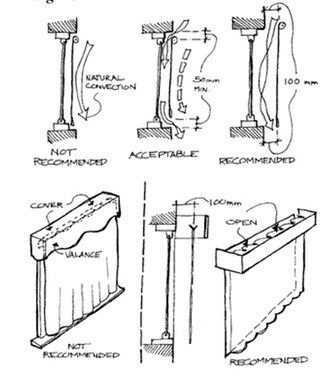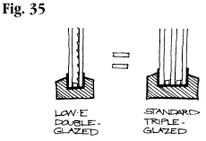Condensation Prevention
Condensation cannot be avoided in principle but can be heavily controlled so it can be prevented from causing lasting damage. Predominately Condensation is found during the winter months especially in the northern hemisphere.
Different ways to prevent it
Manufacturers Techniques

Well Constructed Building Envelope- first of all you need good insulation in all cavity walls, all floors, the roof and where different elements join together to avoid drafts and weak points where the hot air can escape.
Inert Gas- Either Argon or Krypton are used they are chemically stable and non-reactive gases. Predominately Argon is used as its the cheapest and most common. The way in which it prevents condensation is it reduces conduction heat loss because its conductivity is lower than air and reduces convention loss due to it being heavier then air. This enhances the building envelopes strength at its weakest point the windows. (Fig. 37)
Low Emissivity Coating- This technique also known as 'Low E' can be as effective as triple glazing and has the benefit of the reduced weight of transportation and cost of another layer of glass furthermore in the long run eases the wear and tear on the window in general. Therefore it prevents condensation greatly by the insulated qualities of the window at night improve so the building can control the temperature throughout the whole day better. An added bonus is fewer UV rays make it through reducing fading of fabrics and carpets. (Fig. 35)
Insulating Spacers- Having improved the main area of the window itself to avoid drafts the corners of the windows are the weak point when it comes to reducing condensation. The 'Spacer' is part of the frame around the outer part of the window traditionally they used to be made out of hollow aluminium despite its advantages it was very good at conducting heat. Therefore the modern way for becoming energy efficiency point of view and preventing the build up of damaging condensation is to use lower conductivity spacers. At the moment in the market there is a variation in performances and of the techniques I have found this is the area that has not been developed enough.
Non Conducting Sashes and Frames- Like with the Spacers the frame itself is another weak area that is still not fully developed/researched. Frame designers recognise that up to a third of the window could be the frame and even if you have a well insulted window if the frame itself is poor, conduction still happens. Therefore exploration into combining materials and taking advantage of the strengths of each material is a growing trend with manufacturers.
The most successful and commonly used at the moment is to use a fibreglass frame with foam insulation in the frame cavities, so the space is filled with a lower conductive material.
Inert Gas- Either Argon or Krypton are used they are chemically stable and non-reactive gases. Predominately Argon is used as its the cheapest and most common. The way in which it prevents condensation is it reduces conduction heat loss because its conductivity is lower than air and reduces convention loss due to it being heavier then air. This enhances the building envelopes strength at its weakest point the windows. (Fig. 37)
Low Emissivity Coating- This technique also known as 'Low E' can be as effective as triple glazing and has the benefit of the reduced weight of transportation and cost of another layer of glass furthermore in the long run eases the wear and tear on the window in general. Therefore it prevents condensation greatly by the insulated qualities of the window at night improve so the building can control the temperature throughout the whole day better. An added bonus is fewer UV rays make it through reducing fading of fabrics and carpets. (Fig. 35)
Insulating Spacers- Having improved the main area of the window itself to avoid drafts the corners of the windows are the weak point when it comes to reducing condensation. The 'Spacer' is part of the frame around the outer part of the window traditionally they used to be made out of hollow aluminium despite its advantages it was very good at conducting heat. Therefore the modern way for becoming energy efficiency point of view and preventing the build up of damaging condensation is to use lower conductivity spacers. At the moment in the market there is a variation in performances and of the techniques I have found this is the area that has not been developed enough.
Non Conducting Sashes and Frames- Like with the Spacers the frame itself is another weak area that is still not fully developed/researched. Frame designers recognise that up to a third of the window could be the frame and even if you have a well insulted window if the frame itself is poor, conduction still happens. Therefore exploration into combining materials and taking advantage of the strengths of each material is a growing trend with manufacturers.
The most successful and commonly used at the moment is to use a fibreglass frame with foam insulation in the frame cavities, so the space is filled with a lower conductive material.
Home Owners

Condensation Build Up & Prevention tactics- Many household activities (cooking, laundry, dishwasher, showering) result in the chance of condensation becoming more likely due to the humidity increasing. To avoid this make sure the room is well ventilated by having ventilation fans and opening windows during the activity. This will let the extra humidity escape to prevent long-term damage to the walls and prevent visible condensation on the windows.
Blinds/Curtains- To avoid creating a mini climate of high contrast in the home around the window, its important to make sure that near the window there is plenty of opportunity for movement of air and ventilation (Fig. <to the left) Therefore its very important to keep any blinds and covers far enough from the actual window to keep air flowing.
Solar Shading- Brings down the average temperature in and around the house using shadowing devices outside the windows to reduce the contrasting temperature from outside compared to inside the building envelope. Therefore bringing down the risk of condensation. Also trees produce similar results but make sure they are not planted to close to the foundations.
Heating- When heating the home it is not needed in the summer months but in the winter months keeping the house and people in the house is very important but to give the house the best chance of avoiding condensation its best to keep the heating on at a low temperature all day to keep the rooms at a constant temperature and avoid a high constant in temperature once the heating is put back on. Admittedly this is not the cheapest or the most Eco-friendly way to avoid Condensation.
Blinds/Curtains- To avoid creating a mini climate of high contrast in the home around the window, its important to make sure that near the window there is plenty of opportunity for movement of air and ventilation (Fig. <to the left) Therefore its very important to keep any blinds and covers far enough from the actual window to keep air flowing.
Solar Shading- Brings down the average temperature in and around the house using shadowing devices outside the windows to reduce the contrasting temperature from outside compared to inside the building envelope. Therefore bringing down the risk of condensation. Also trees produce similar results but make sure they are not planted to close to the foundations.
Heating- When heating the home it is not needed in the summer months but in the winter months keeping the house and people in the house is very important but to give the house the best chance of avoiding condensation its best to keep the heating on at a low temperature all day to keep the rooms at a constant temperature and avoid a high constant in temperature once the heating is put back on. Admittedly this is not the cheapest or the most Eco-friendly way to avoid Condensation.



